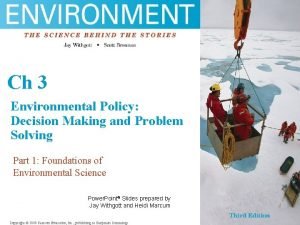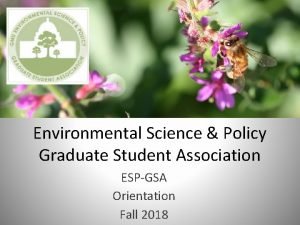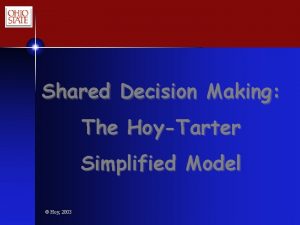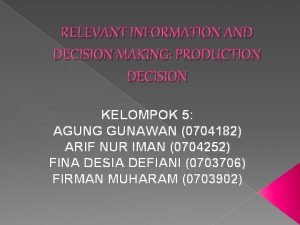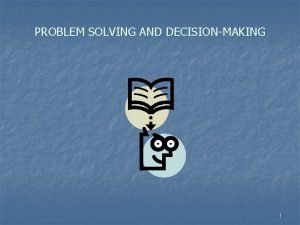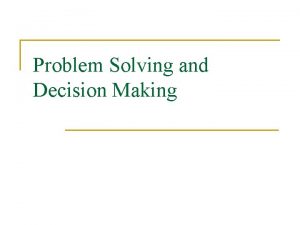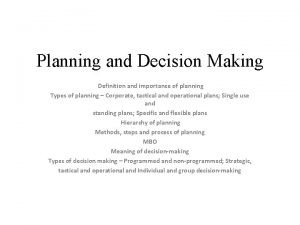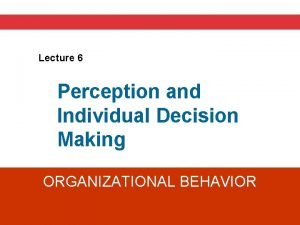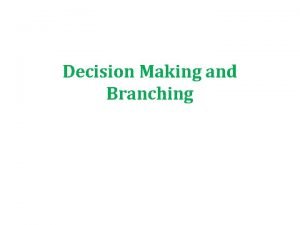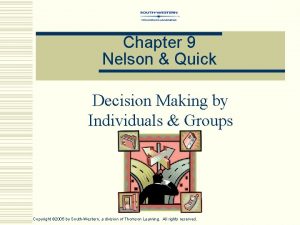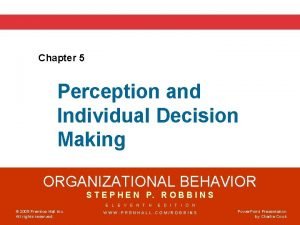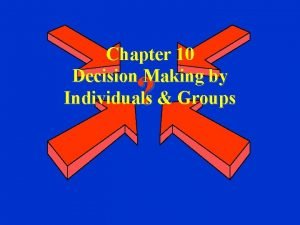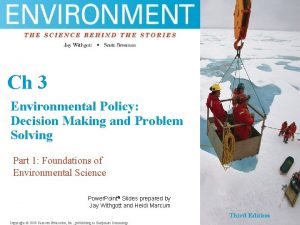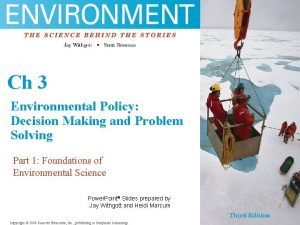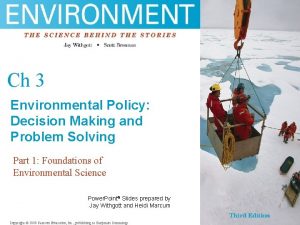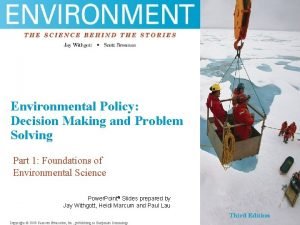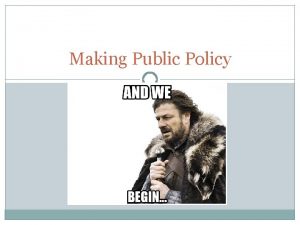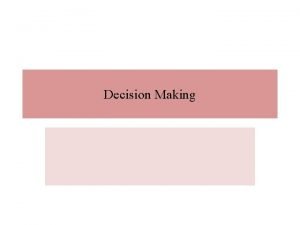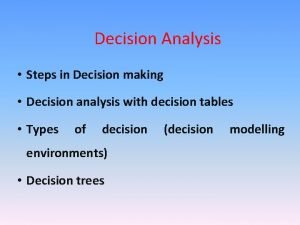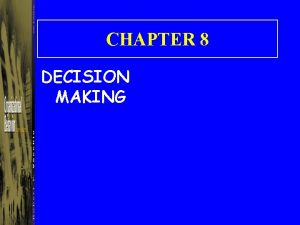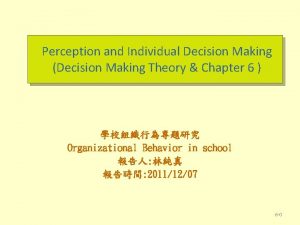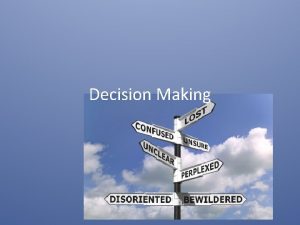Chfgh 3 Environmental Policy sfg Decision Making and



























- Slides: 27

Chfgh 3 Environmental Policy: sfg Decision Making and Problem Solving dfg Part 1: Foundations of Environmental Science Power. Point® Slides prepared by Jay Withgott and Heidi Marcum Copyright © 2006 Pearson Education, Inc. , publishing as Benjamin Cummings Copyright © 2008 Pearson Education, Inc. , publishing as Benjamin Copyright © 2008 Pearson Education, publishing as Pearson. Cummings Benjamin Cummings

San Diego and Tijuana • The Tijuana River empties into the Pacific Ocean, carrying millions of gallons of untreated wastewater • San Diego’s waters receive storm water runoff • Beaches are off-limits to swimming • Rains wash pollutants onto U. S. and Mexican beaches, but things are worse on the Mexican side Copyright © 2008 Pearson Education, Inc. , publishing as Pearson Benjamin Cummings

Environmental policy • Environmental Policy = pertains to human interactions with the environment • Regulates resource use or reduce pollution Copyright © 2008 Pearson Education, Inc. , publishing as Pearson Benjamin Cummings

Environmental policy and resource use • Policies include science, ethics, and economics • Market failure = businesses or individuals don’t minimize environmental impact • Justification for government intervention • The tragedy of the commons = we must develop guidelines for commonly held resources • The threat of overexploitation is a driving force behind much environmental policy Copyright © 2008 Pearson Education, Inc. , publishing as Pearson Benjamin Cummings

Environmental policy and equity • Free Riders = reducing pollution tempts any one person to cheat • Private voluntary efforts are less effective than mandated efforts • External Cost = harmful impacts result from market transaction but are borne by people not involved in the transaction Environmental policy goals = protect resources against the tragedy of the commons and to promote equity by eliminating free riders and addressing external costs Copyright © 2008 Pearson Education, Inc. , publishing as Pearson Benjamin Cummings

Why are environmental laws unpopular? • Environmental laws are challenged, derided, and ignored • Environmental policy involves government regulations • Businesses and individuals view laws as overly restrictive and unresponsive to human needs • Most environmental problems are long-term processes • Human behavior is geared toward short-term needs • News media have short attention spans • Politicians act out of their own short-term interest Copyright © 2008 Pearson Education, Inc. , publishing as Pearson Benjamin Cummings

State and local policies affect environmental issues • Important environmental policy is also created at the state and local levels • State laws cannot violate principles of the U. S. Constitution, • If laws conflict, federal laws take precedence • California, New York, and Massachusetts have strong environmental laws • The interior western states put less priority on environmental protection and favor unregulated development Copyright © 2008 Pearson Education, Inc. , publishing as Pearson Benjamin Cummings

Constitutional amendments and environmental law • Fourteenth Amendment of the U. S. Constitution • Prohibits denying “equal protection of its laws” • It’s the Constitutional basis for the environmental justice movement • Fifth Amendment = takings clause • Bans the literal taking of private property • Also bans regulatory take, which deprives a property owner of economic uses of the property • There is a sensitive balance between private rights and the public good Copyright © 2008 Pearson Education, Inc. , publishing as Pearson Benjamin Cummings

Early U. S. environmental policy • Involved management of public lands, 1780 s to the late 1800 s • Promoted settlement • Extraction of natural resources • Increased prosperity • Relieved crowding in Eastern cities • Displaced millions of Native Americans • People believed that land was infinite and inexhaustible Copyright © 2008 Pearson Education, Inc. , publishing as Pearson Benjamin Cummings

The second wave of U. S. policy • Addressed impacts caused by the first wave • Public perception and government policy shifted • Mitigated environmental problems associated with westward expansion • Yellowstone National Park, the world’s first national park, opened in 1872 • Other protected areas were created • National wildlife refuges, parks, and forests • Reflected a new understanding that the West’s resources were exhaustible and required legal protection Copyright © 2008 Pearson Education, Inc. , publishing as Pearson Benjamin Cummings

The third wave of U. S. environmental policy • Mid-to late-20 th century • Better off economically • But dirtier air, dirtier water, and more waste and toxic chemicals • Increased awareness of environmental problems shifted public priorities and policy • 1962: Silent Spring (by Rachel Carson) described the negative ecological and health effects of pesticides and industrial chemicals Copyright © 2008 Pearson Education, Inc. , publishing as Pearson Benjamin Cummings

Modern U. S. environmental policy • The Cuyahoga River was polluted with oil and industrial waste • It caught fire in the 1950 s and 1960 s • Today, public enthusiasm for environmental protection remains strong • The majority of Americans favor environmental protection • In April, millions of people celebrate Earth Day Copyright © 2008 Pearson Education, Inc. , publishing as Pearson Benjamin Cummings

The National Environmental Policy Act (NEPA) • 1970 began the modern era of environmental policy • Created the Council on Environmental Quality - Requires an Environmental Impact Statement (EIS) for any federal action that might impact the environment NEPA forces the government and businesses to evaluate the environmental impacts of a project Copyright © 2008 Pearson Education, Inc. , publishing as Pearson Benjamin Cummings

The EPA shifts environmental policy • Nixon created the Environmental Protection Agency (EPA) • Conducts and evaluates research • Monitors environmental quality • Sets and enforces standards for pollution levels • Assists states in meeting standards and goals • Educates the public Copyright © 2008 Pearson Education, Inc. , publishing as Pearson Benjamin Cummings

Significant environmental laws • The public demanded a cleaner environment and supported tougher environmental legislation Copyright © 2008 Pearson Education, Inc. , publishing as Pearson Benjamin Cummings

The social context for policy can change • Three factors converged to allow major advances in environmental policy in the 1960 s and 1970 s • Wide evidence of environmental problems • People could visualize policies to deal with problems • The political climate was ripe, with a supportive public and leaders who were willing to act • In recent years, the political climate has changed • People felt burdened by environmental regulations • Attempts have been made to roll back or weaken environmental laws Copyright © 2008 Pearson Education, Inc. , publishing as Pearson Benjamin Cummings

The Earth Summit Rio de Janeiro, Brazil, in 2002 • The largest international diplomatic conference ever held • It centered on the idea of sustainable development • This fourth wave of environmental policy focuses on sustainable development • Finding ways to safeguard natural systems while raising living standards for the world’s poorest people Copyright © 2008 Pearson Education, Inc. , publishing as Pearson Benjamin Cummings

International Environmental Policy • International issues can be addressed through creative agreements • Montreal Protocol: nations agreed to reduce ozonedepleting chemicals • Kyoto Protocol: reduces fossil fuel emissions causing climate change Copyright © 2008 Pearson Education, Inc. , publishing as Pearson Benjamin Cummings An international wastewater treatment plant

Organizations help shape international policy • International organizations influence the behavior of nations • Providing funding, applying peer pressure, directing media attention • United Nations Environment Programme (UNEP) = helps nations understand solve environmental problems • The European Union seeks to promote Europe’s unity and economic and social progress • Can enact binding regulations • Can also issue advisory directives Copyright © 2008 Pearson Education, Inc. , publishing as Pearson Benjamin Cummings

The World Trade Organization (WTO) • Represents multinational corporations to promote free trade • Has authority to impose penalties on nations the don’t comply with its directives • Interprets some environmental laws as unfair barriers to free trade • Brazil and Venezuela filed a complaint against the U. S. EPA’s regulations requiring cleaner-burning fuel • The WTO agreed with Brazil and Venezuela, despite threats to human health • Critics charge the WTO aggravates environmental problems Copyright © 2008 Pearson Education, Inc. , publishing as Pearson Benjamin Cummings

NGOs and the World Bank • Nongovernmental Organizations (NGOs) = entities that influence international policy • Some do not get politically involved • Others try to shape policy through research, lobbying or protest • The World Bank = one of the world’s largest funding sources for development • Dams, irrigation, infrastructure • Funds unsustainable, environmentally damaging projects Copyright © 2008 Pearson Education, Inc. , publishing as Pearson Benjamin Cummings

Science plays a role, but can be politicized • Effective policy decisions are informed by scientific research • Sometimes policymakers ignore science • They let political ideology determine policy • Scientists at government agencies have had their work suppressed or discredited - Their jobs were threatened When taxpayer-funded research is suppressed or distorted for political ends, everyone loses Copyright © 2008 Pearson Education, Inc. , publishing as Pearson Benjamin Cummings

Approaches to environmental policy • Command-control approach: environmental policy sets rules or limits and threatens punishment for violators • Heavy-handed • Alternative approaches involve using economic incentives to encourage desired outcomes and use market dynamics to meet goals • Most current environmental laws - Have resulted in safe, healthy, comfortable lives Copyright © 2008 Pearson Education, Inc. , publishing as Pearson Benjamin Cummings

Drawbacks of command-control • Government actions may be well-intentioned but not informed • Interest groups–people seeking private gain–unduly influence politicians • Citizens may view policies as restrictions on freedom • Costly and less efficient in achieving goals Copyright © 2008 Pearson Education, Inc. , publishing as Pearson Benjamin Cummings

Widespread economic policy tools • Tax breaks = encourage desirable industries or activities • Subsidy = a government giveaway of cash or resources to encourage a particular activity • Have been used to support unsustainable activities In 2003, $58 billion of taxpayer’s money was spent on 68 environmentally harmful subsidies such as building logging roads Copyright © 2008 Pearson Education, Inc. , publishing as Pearson Benjamin Cummings

Another economic policy tool • Green taxes = taxes on environmentally harmful activities • Polluter pays principle = the price of a good or service includes all costs, including environmental degradation • Gives companies financial incentives to reduce pollution • But, costs are passed on to consumers Copyright © 2008 Pearson Education, Inc. , publishing as Pearson Benjamin Cummings

Market permitting and incentives • Permit trading = government-created market in permits • Businesses buy, sell, trade these permits • Emissions trading system = government-issued permits for an acceptable amount of pollution and companies buy, sell, or trade these permits with other polluters • Cap-and-trade system = a party that reduces its pollution levels can sell this credit to other parties - Pollution is reduced overall, but does increase around polluting plants • Companies have an economic incentive to reduce emissions Copyright © 2008 Pearson Education, Inc. , publishing as Pearson Benjamin Cummings
 Chfgh
Chfgh No decision snap decision responsible decision
No decision snap decision responsible decision Financial management process
Financial management process Functional grammar
Functional grammar Sfg sfgsfg
Sfg sfgsfg Environmental science chapter 2
Environmental science chapter 2 Esp gmu
Esp gmu Decision table and decision tree examples
Decision table and decision tree examples Mamdm
Mamdm Using functions in models and decision making
Using functions in models and decision making Chapter 6 prices and decision making assessment answers
Chapter 6 prices and decision making assessment answers Model hoy
Model hoy Decision making and relevant information
Decision making and relevant information Best books on problem solving and decision making
Best books on problem solving and decision making Individual and group decision making
Individual and group decision making Nature of decision making
Nature of decision making Perception and individual decision making
Perception and individual decision making Steps in decision making
Steps in decision making A is a choice made from among available alternatives
A is a choice made from among available alternatives Chapter 2 economic systems and decision making
Chapter 2 economic systems and decision making Decision making and branching in c
Decision making and branching in c Elements of planning
Elements of planning Individual and group decision making
Individual and group decision making Management chapter 5 planning and decision making
Management chapter 5 planning and decision making Perception and decision making in organizational behavior
Perception and decision making in organizational behavior Decision making goal setting
Decision making goal setting Chapter 2 economic systems and decision making
Chapter 2 economic systems and decision making Individual and group decision making
Individual and group decision making
